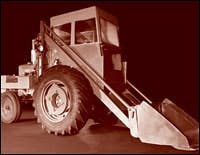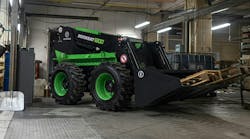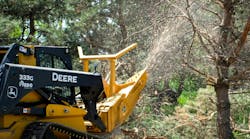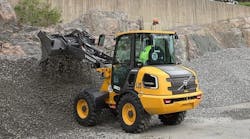Last year, Volvo celebrated a half century of wheel-loader manufacture. Today's sophisticated machines bear little resemblance to the company's pioneering H10 wheel loader of 1954, but its simplicity and reliability gained it instant success and earned it a reputation that would associate the Volvo name with wheel loaders the world over.
The 1-ton-capacity H10 was essentially a back-to-front farm tractor with its hydraulic loader attachment placed over the larger rear wheels, thus making it possible to carry heavier loads with a higher breakout force. It was also the first wheel loader to be equipped with an attachment bracket to enable rapid changing of bucket and attachment. This innovation became a Volvo trait and evolved into the "quick-hitch" or tool carrier offered by most of today's loader manufacturers.
The H10 was produced for five years before being superseded by the LM 218, a machine purpose-built as a wheel loader from the ground up. In 1965, Volvo introduced loaders with four-wheel drive and power-shift transmissions. Articulated models appeared in 1970, and 1980 saw the launch of a new generation of loaders that Volvo claimed were the world's first with automatic power-shift.
Volvo's history began in 1832 when Johan Teofron Munktell founded the engineering firm of Eskilstuna Mekaniska Verkstad at Eskilstuna, Sweden. In 1844, brothers Jean and Carl Gerard Bolinder founded a parallel engineering company that by 1920 was the market leader in marine compression engine manufacture. The Bolinder and Munktell companies merged in 1932 under the name of Bolinder-Munktell and became the biggest manufacturer of tractors and agricultural machinery in Sweden. It was these tractors that formed the basis for the H10 wheel loader.
During World War II, collaboration between Bolinder-Munktell and Volvo resulted in Volvo acquiring the company in 1950, changing the name to Volvo BM. It then became part of the VME Group (Volvo, Michigan, Euclid) in 1985. Volvo gained access to the Michigan line of wheel loaders, whose designs enhanced Volvo's own, resulting in a single line of loaders, the L-series, marketed under the Volvo name.
You can read more about the evolution of construction equipment in Keith Haddock's illustrated book "The Earthmover Encyclopedia," available in most bookstores. Also, consider a membership in the Historical Construction Equipment Association, www.hcea.net.






